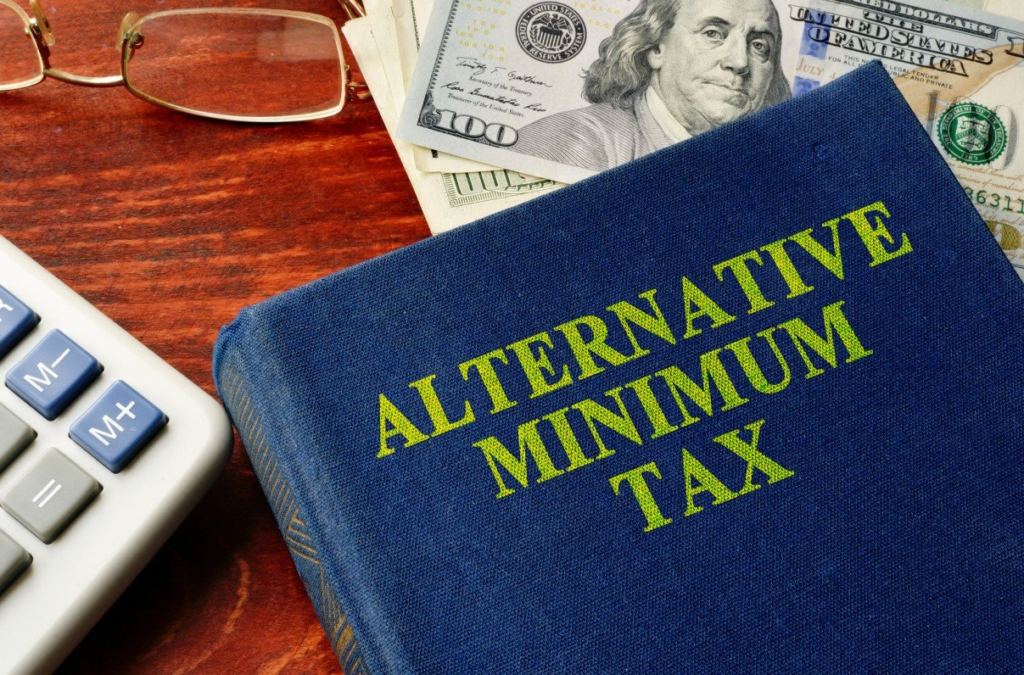Alternative Minimum Tax (AMT)
The alternative minimum tax was originally enacted to ensure that high-income taxpayers pay at least a minimum amount of tax if they benefit from certain deductions and other tax preference items.
The AMT tax computation is a parallel system to the regular tax system with its own definitions of income and expenses, rules for income recognition and timing, exemptions, and tax rates. Although every taxpayer is subject to Alternative Minimum Tax rules, the additional tax is paid only if the tax computation under AMT rules is higher than the tax computed under regular rules.
Even though the Alternative Minimum Tax was originally targeted toward high-income taxpayers, factors, including inflation and treatment of certain tax credits, can sometimes push lower-income taxpayers into an AMT situation.
How AMT Works
Certain items called adjustments and preferences are added to or subtracted from federal adjusted gross income reduced by any itemized deductions. An Alternative Minimum Tax exemption amount is allowed, depending on the taxpayer’s filing status. The AMT tax rate of 26% to 28% is applied to the resulting alternative minimum taxable income. If the resulting tax is greater than regular tax, the difference is added to regular tax on Form 1040.
Example #1:
When computed under regular rules, John’s income tax is $4,700. When computed under AMT rules, the tax amount is $3,900. Since his tax computed under AMT rules is less than his tax computed under regular rules, John will not pay any additional amount for AMT.
Example #2:
Assume the same facts as Example #1, except when computed under Alternative Minimum Tax rules, John’s tax amount is $5,100. Since his tax computed under AMT rules is higher than his tax computed under regular rules, John must pay the difference in additional tax. John must report additional Alternative Minimum Tax in the amount of $400.
AMT Triggers
Items that commonly trigger Alternative Minimum Tax include deductions for state and local taxes, and exercise of incentive stock options. Other AMT adjustments and preferences include:
- Taxes from Schedule A (Form 1040).
- Tax refunds reported on Form 1040.
- Certain Investment interest expense
- Certain depletion expense
- Net operating losses
- Interest from specified private activity bonds
- A portion of gain from section 1202 small business stock
- Exercise of incentive stock options
- Certain gains from dispositions of property
- Certain depreciation adjustments
- Passive activity gains and losses
- Alternative Minimum Tax loss limitations
- Certain circulation costs
- Long-term contracts
- Certain mining costs
- Certain research and experimental costs
- Pre-1987 installment sale income
- Intangible drilling cost preferences
- Alternative Minimum Tax Exemptions Amount
| Filing Status | 2021 | 2020 |
| Single or Head of Household | $73,600 | $72,900 |
| Married Filing Jointly | $114,600 | $113,400 |
| Married Filing Separately | $57,300 | $56,700 |
Incentive Stock Options—AMT Adjustments
The bargain element resulting from exercise of incentive stock options (ISO) is equal to the fair market value (FMV) of the stock minus the exercise price and is a deferral item for AMT purposes.
| Event | Regular Tax Treatment | AMT Adjustment |
| Exercise of ISO | No Tax Due on ISO Exercise | • Positive AMT adjustment on line 2i, Form 6251, equal to bargain element. * • Increase AMT basis of stock by amount of adjustment |
| Sales of Stock | Tax treatment depends on whether required holding period is met. | • Negative AMT adjustment on line 2k, Form 6251, equal to bargain element. * • Adjustment is result of previous increase in AMT basis. |
* No adjustment is made if exercise and sale occur in the same tax year
Form 3921, Exercise of an Incentive Stock Option Under Section 422(b), may help in computing the adjustment.
Example: Cindy exercised an ISO to acquire 100 shares of stock in 2021. Her rights in the acquired stock first became transferable on the date she exercised the ISO and were not subject to a substantial risk of forfeiture. She did not pay anything for the ISO and did not sell the acquired stock during 2020. Cindy received Form 3921 that shows $10 in box 3 (the exercise price paid for each share), $25 in box 4 (the fair market value of each share on the exercise date), and 100 shares in box 5 (the number of shares acquired). To calculate the adjustment, multiply the amount in box 4, $25, by the 100 shares in box 5. The result is $2,500, the fair market value of all the shares. Then multiply the amount in box 3, $10, by the 100 shares in box 5. The result is $1,000, the amount paid for all the shares. Cindy’s AMT adjustment is $1,500 ($2,500 − $1,000).
Potential tax credit. If the Alternative Minimum Tax adjustment due to exercise of an ISO results in an AMT liability, an AMT credit may be available in subsequent tax years.
Personal Credits
An individual can claim nonrefundable personal credits against regular tax and AMT.
| Form/Sch. | |
| Adoption Credit | 8839 |
| America Opportunity Credit and Lifetime Learning Credit | 8863 |
| Child and Dependent Care Expense Credit | 2441 |
| Child Tax Credit | 1040 |
| Credit for Other Dependents | 1040 |
| Credit for the Elderly or the Disabled. | Sch. R |
| Foreign Tax Credit (see foreign tax credit and AMT, below) | 1116 |
| Mortgage Interest Credit | 8396 |
| Qualified Plug-in Electric Drive Motor Vehicle Credit | 8936 |
| Residential Energy Efficient Property Credit | 5695 |
| Retirement Savings Contribution Credit | 8880 |
Foreign Tax Credit and AMT
The AMT treatment of the Foreign Tax Credit depends on whether Form 1116, Foreign Tax Credit, is being filed.
| Taxpayer elects not to file Form 1116. | • Report Foreign Tax Credit on Form 1040. • Credit is limited to amount of regular tax. • Unused foreign tax may not be carried over. |
| Taxpayer elects to file Form 1116. | • Recalculate Foreign Tax Credit using AMT rules. • AMT Foreign Tax Credit is used to offset AMT on Form 6251. • Unused AMT Foreign Tax Credit may be carried back one year and carried forward ten years. [IRC §904(c)] |
Credit for Prior Year AMT
The adjustments and preferences that result in AMT are of two types.
1)
Deferral items, such as AMT basis adjustments, are temporary and do not cause a permanent difference in taxable income over time.
2)
Exclusion items, such as taxes from Schedule A (Form 1040), are not allowed for AMT and therefore cause a permanent difference in taxable income.
The potential exists for income from deferral items to be taxed twice—first under AMT, and again in a later year under regular tax. A credit against regular tax for prior year AMT is available to address this situation.
Contact Us
There are many events that occur during the year that can affect your tax situation. Preparation of your tax return involves summarizing transactions and events that occurred during the prior year. In most situations, treatment is firmly established at the time the transaction occurs. However, negative tax effects can be avoided by proper planning. Please contact us in advance if you have questions about the tax effects of a transaction or event, including the following:
- Pension or IRA distributions
- Significant change in income or deductions
- Job change
- Marriage
- Attainment of age 59½ or 72
- Sale or purchase of a business
- Sale or purchase of a residence or other real estate
- Retirement
- Notice from IRS or other revenue department.
- Divorce or separation
- Self-employment
- Charitable contributions of property in excess of $5,000







